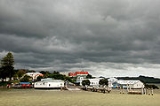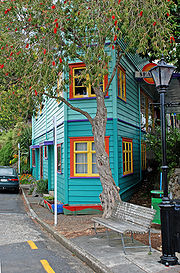
Rawene
Encyclopedia
Rawene is a town on the south side of the Hokianga
harbour, in Northland, New Zealand
. State Highway 12 passes to the south. The town lies at the apex of a peninsula. A car ferry links it to Kohukohu
and the northern Hokianga.
The population was 438 in the 2006 Census, a decrease of 24 from 2001.

 Rawene started as a timber centre, with a mill and shipyards established in the early 19th century. An attempted settlement by the first New Zealand Company
Rawene started as a timber centre, with a mill and shipyards established in the early 19th century. An attempted settlement by the first New Zealand Company
in 1826 failed. Captain James Herd in 1822 had taken out the first shipment of kauri
from the Hokianga in his ship Providence. In 1825 he returned as an agent for the company sailing the Rosanne in company with the Lampton, and 60 settlers between the two vessels. They began at Stewart Island/Rakiura
and sailed up the east coast, leaving Lampton as a place name in Wellington
, eventually rounding North Cape
to enter Hokianga - his old stamping ground. Herd negotiated to buy a vast tract of land. The deal was contested but for decades Europeans referred to the town as "Herd's Point". Later it was called "Hokianga Township", and in 1884 it became "Rawene", possibly to identify the post office and telegraph.
The post office was operating by 1845 - one of eight in the country.
Aperahama Taonui, chief of Te Popoto hapū, is said to have operated a school at Rawene in the mid-19th century.
James Reddy Clendon
, previously the United States Consul
to New Zealand, settled in Rawene in 1862 and served as the local magistrate under the Native Circuit Courts Act until 1867. His house still stands and is open to the public.
By 1872, there were two hotels in Rawene, and two stores. There was a Wesleyan church, and the Roman Catholics owned a section. Von Sturmer was the Postmaster, Customs Officer and Magistrate.
During the Dog Tax War
of 1898, Rawene was evacuated after the tax rebels threatened to march on the town. On 5 May 1898 120 men marched from Rawene to Waima to deal with the revolters, but the dispute was settled without them.
A small cottage hospital was built on a hill overlooking the town in 1910. A new hospital was completed in 1928. Dr George McCall Smith headed the hospital from 1914 to 1948 and developed a unique health system for the Hokianga.
Dr Smith became a practitioner of 'painless childbirth' in the early 1930s, using premedication with the barbiturate Nembutal combined with hyosine. This proved very popular and attracted women to Rawene from far afield. The annual average of thirty births per year now peaked at two hundred. in 1937 a 'Commission of Inquiry into Rural Maternity Services' was established with Smith's practice as its primary concern. Smith fronted up with case notes on his last two hundred patients, and his results could not be bettered anywhere.
The area was declared a special health area in the 1940s. This meant that all medical officers in the Hokianga were salaried, and all consultations, pharmaceuticals, investigations and hospital admissions were free. The whole scheme was funded through a per capita grant.
of 2 and a roll of 80.
A room for secondary students was added to Rawene Primary School in 1922. In 1947 a stand-alone Rawene District High School was built. It was extended in 1952, but was destroyed by fire in 1972.
The Rawene Learning Centre is a campus of NorthTec
polytechnic.
Hokianga
Hokianga is an area surrounding the Hokianga Harbour, also known as The Hokianga River, a long estuarine drowned valley on the west coast in the north of the North Island of New Zealand....
harbour, in Northland, New Zealand
New Zealand
New Zealand is an island country in the south-western Pacific Ocean comprising two main landmasses and numerous smaller islands. The country is situated some east of Australia across the Tasman Sea, and roughly south of the Pacific island nations of New Caledonia, Fiji, and Tonga...
. State Highway 12 passes to the south. The town lies at the apex of a peninsula. A car ferry links it to Kohukohu
Kohukohu
Kohukohu may refer to:*Pittosporum tenuifolium, a small evergreen tree*Kohukohu, a settlement in the Hokianga region of New Zealand....
and the northern Hokianga.
The population was 438 in the 2006 Census, a decrease of 24 from 2001.
History


New Zealand Company
The New Zealand Company originated in London in 1837 as the New Zealand Association with the aim of promoting the "systematic" colonisation of New Zealand. The association, and later the company, intended to follow the colonising principles of Edward Gibbon Wakefield, who envisaged the creation of...
in 1826 failed. Captain James Herd in 1822 had taken out the first shipment of kauri
Agathis australis
Agathis australis, commonly known as the kauri, is a coniferous tree found north of 38°S in the northern districts of New Zealand's North Island. It is the largest but not tallest species of tree in New Zealand, standing up to 50 m tall in the emergent layer above the forest's main canopy. The...
from the Hokianga in his ship Providence. In 1825 he returned as an agent for the company sailing the Rosanne in company with the Lampton, and 60 settlers between the two vessels. They began at Stewart Island/Rakiura
Stewart Island/Rakiura
Stewart Island/Rakiura is the third-largest island of New Zealand. It lies south of the South Island, across Foveaux Strait. Its permanent population is slightly over 400 people, most of whom live in the settlement of Oban.- History and naming :...
and sailed up the east coast, leaving Lampton as a place name in Wellington
Wellington
Wellington is the capital city and third most populous urban area of New Zealand, although it is likely to have surpassed Christchurch due to the exodus following the Canterbury Earthquake. It is at the southwestern tip of the North Island, between Cook Strait and the Rimutaka Range...
, eventually rounding North Cape
North Cape, New Zealand
North Cape is located at the northern end of the North Auckland Peninsula in the North Island of New Zealand . It is the northeastern tip of the Aupouri Peninsula and lies 30 km east of Cape Reinga. The name is sometimes used to refer just to the cape which is known in Māori as Otou and which...
to enter Hokianga - his old stamping ground. Herd negotiated to buy a vast tract of land. The deal was contested but for decades Europeans referred to the town as "Herd's Point". Later it was called "Hokianga Township", and in 1884 it became "Rawene", possibly to identify the post office and telegraph.
The post office was operating by 1845 - one of eight in the country.
Aperahama Taonui, chief of Te Popoto hapū, is said to have operated a school at Rawene in the mid-19th century.
James Reddy Clendon
James Reddy Clendon
James Reddy Clendon was an early European settler in New Zealand, the first United States Consul to New Zealand, and a witness to the Treaty of Waitangi.-Early life:...
, previously the United States Consul
United States Ambassador to New Zealand
The United States has maintained a consular presence in New Zealand since 1838. The first consul was James Reddy Clendon. Born in England, Clendon was a ship owner and merchant who bought land and settled in the Bay of Islands, New Zealand. In 1838 he was appointed by the federal government of the...
to New Zealand, settled in Rawene in 1862 and served as the local magistrate under the Native Circuit Courts Act until 1867. His house still stands and is open to the public.
By 1872, there were two hotels in Rawene, and two stores. There was a Wesleyan church, and the Roman Catholics owned a section. Von Sturmer was the Postmaster, Customs Officer and Magistrate.
During the Dog Tax War
Dog Tax War
The Dog Tax war is described by some authors as the last gasp of the 19th century wars between the Māori and the Pākehā, the British settlers of New Zealand. This is not altogether accurate in two respects. It was a very minor affair, certainly not a war...
of 1898, Rawene was evacuated after the tax rebels threatened to march on the town. On 5 May 1898 120 men marched from Rawene to Waima to deal with the revolters, but the dispute was settled without them.
A small cottage hospital was built on a hill overlooking the town in 1910. A new hospital was completed in 1928. Dr George McCall Smith headed the hospital from 1914 to 1948 and developed a unique health system for the Hokianga.
Dr Smith became a practitioner of 'painless childbirth' in the early 1930s, using premedication with the barbiturate Nembutal combined with hyosine. This proved very popular and attracted women to Rawene from far afield. The annual average of thirty births per year now peaked at two hundred. in 1937 a 'Commission of Inquiry into Rural Maternity Services' was established with Smith's practice as its primary concern. Smith fronted up with case notes on his last two hundred patients, and his results could not be bettered anywhere.
The area was declared a special health area in the 1940s. This meant that all medical officers in the Hokianga were salaried, and all consultations, pharmaceuticals, investigations and hospital admissions were free. The whole scheme was funded through a per capita grant.
Education
Rawene School is a coeducational full primary (years 1-8) school with a decile ratingSocio-Economic Decile
Decile, Socio-Economic Decile or Socio-Economic Decile Band is a widely used measure in education in New Zealand used to target funding and support to more needy schools....
of 2 and a roll of 80.
A room for secondary students was added to Rawene Primary School in 1922. In 1947 a stand-alone Rawene District High School was built. It was extended in 1952, but was destroyed by fire in 1972.
The Rawene Learning Centre is a campus of NorthTec
NorthTec
NorthTec is the largest tertiary education provider in northern New Zealand. NorthTec is the only Northland-based Tertiary Education Institute that provides programmes ranging from foundation, certificate, diploma and degree levels....
polytechnic.
Notable people
- Norm MaxwellNorm MaxwellNorman Michael Clifford Maxwell is a New Zealand rugby union player. His usual position is at lock. He is 1.98m tall and weighs 106 kg. He played for Canterbury in the NPC and he also represented Crusaders in the Super 12 rugby competition...
, rugby union footballer and All Black. - Ron GuthreyRon GuthreyAlbert Ronald Guthrey OBE MC was a councillor for Christchurch City Council for 22 years before being elected Mayor of Christchurch. He was a World War II veteran and he and his family were well known business operators in Christchurch.-Early life:Guthrey was born in Rawene, Hokianga on 15...
, mayor of Christchurch (1968 to 1971). - Gordon CochraneGordon Cochrane (pilot)Alfred William 'Gordon' Cochrane DSO, DFC and two bars was an officer of the Royal New Zealand Air Force during the Second World War. He is one of only four New Zealand born airmen to receive two medal bars to his Distinguished Flying Cross.-Career:Cochrane was born on 10 October 1916 in Rawene,...
, WWII RNZAF bomber pilot.

